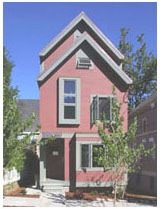Infill Housing Incentives

A few programs worth reading about that provide incentives for the creation of new housing within aging urban areas. Aside from tax financing packages to offset costs of re-claiming urban lots, the following cities are attempting the following initiatives to make new residential construction more financially competitive with suburban greenfield housing.
Sacramento
From the current Regulatory Barriers Clearinghouse newsletter, the City of Sacramento is featured for its new initiative to provide pre-approved house plans for infill housing within the city. The 'Infill Coordinator' with the City of Sacramento notes that "a 2002 report indicates that over 5,000 vacant and/or blighted properties exist in Sacramento. The report estimates that these properties cover over 2,500 acres and have the potential to provide space for over 17,800 dwellings. Of this total, 70 percent, or 3,500 vacant parcels, were 10,000 square feet or smaller." Pre-approved house plans can be purchased from the City and expedite beginning of construction by as much as six weeks.
Portland
The Portland Living Smart Program arose as a response to infill development queries on vacant 25-foot lots. The City of Portland initiated a design competition to create the Portland Catalogue for Narrow House Designs (Dec 2004) to provide a resourse for building on these parcels. From the Living Smart Program website: "After the competition was finished, the City wanted to take Living Smart one step further by providing the public with affordable plan sets of well designed narrow lot houses. BDS contracted with two designers, who were both Jury and People's Choice award winners, to prepare a set of house plans that would be available to the public." The selected designs were granted 'permit ready' by the City Council and provided owners and builders a simplified process to building well-designed houses (as determined by the public and competition jury) on narrow residential lots. The image above is Bryan Higgins design for a house which was one of two selected from 426 submissions to be granted 'permit ready.'
Cleveland
To encourage the development of vacant parcels in Cleveland neighborhoods, the Department of Community Development maintains one of the nation's first residential Land Banks. Lots are compiled and categorized as one of three types: non-buildable lots, $100 buildable lots and future development. To purchase a property from the City's inventory of buildable lots and build a house, a written request for the site and a detailed proposal must be approved by Council. After approval, the property is sold for $100 to the new owner who must commence construction within the following three months and finish construction in one year's time.

0 Comments:
Post a Comment
<< Home